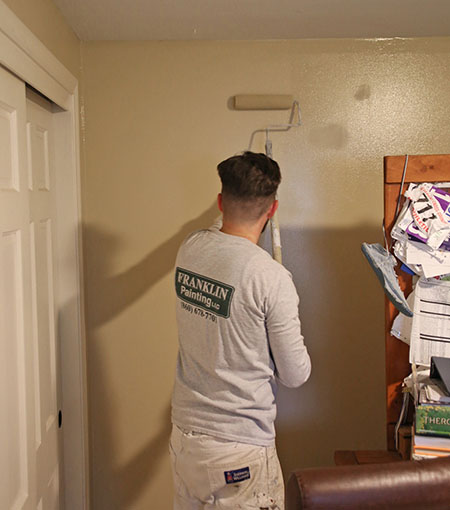How to Paint Over a Dark Color
There’s no need to look dreadfully at a room painted in a dark shade when you prefer a lighter hue. Making the change is easy once you know how to paint over a dark color. A total lack of patience is one possible hitch, and insufficient time to do the job right is another. Call the pros at Franklin Painting to do the work in such cases. Otherwise, you can breathe easily and transform any room with dark walls into a lighter version of itself by following the steps below.
 Gather the Right Equipment
Gather the Right Equipment
To achieve professional results, begin with the correct equipment as you paint over a dark color with a light shade. The rollers, brushes, primer, and paint you buy must all be high-quality products. They also need to be the specific items you need for the job.
■ Rollers should have a thicker nap when the wall surface is rough. A thinner nap is perfect when the wall is smooth.
■ Buy top-quality primer and paint, only buying proven brands such as Sherwin-Williams or Benjamin Moore.
■ The primer you need for painting over a dark color contains many binders and pigments. These components do the job of blocking out the dark color underneath.
■ When switching from dark paint to a light color, choose a white primer. (Note: Do not make the common mistake of using a darker
primer such as gray because the results will
be less than satisfying.)
Prep Properly
Proper surface prep is the standard procedure for any painting project, and it is especially crucial when painting over dark paint with a light color. Prepping to paint involves the following basic steps, though getting rid of mold and mildew are examples of circumstances in which more than the basic may be required:
- First, patch and repair nail holes and other wall blemishes.
- Using a microfiber cloth, thoroughly wipe down surfaces to remove dust.
- Use a mild cleaner and rag to remove smudges and stubborn stains.
- In the kitchen, a degreaser is also needed during the cleaning process.
- Use a scraper to remove peeling or chipped paint and sand well.
- As required after the cleaning process, allow the surface to dry completely.
Apply Two Coats of Primer
Two coats of primer should be applied when blocking out a dark paint color. Lay the paint thick and allow each coat to dry thoroughly before continuing to the next step.
 Apply Paint
Apply Paint
The prep and primer have provided the necessary groundwork for an excellent finish. Apply your chosen light paint using pro tips. Remember that professional painters who deliver excellent workmanship have job security for a reason. If you are not confident you can give the necessary time and care to a home interior or exterior painting project, contact the professionals at Franklin Painting.
No matter what your painting needs, you don’t need to know how to paint over a dark color. Rely on our professional painting crew at Franklin Painting to deliver unbeatable results.
Call 877.646.7774 today or contact us online to schedule an appointment for a free estimate!
Frequently Asked Questions
1. What primer should I use to cover a dark wall color?
When painting over a dark color, using a high-quality, stain-blocking primer is crucial to ensure the new paint color covers effectively and looks vibrant. Look for a primer specifically for covering dark colors; these are typically labeled as “high-hide” primers and are formulated to provide a neutral base that minimizes the number of topcoats needed.
2. How many coats of primer are necessary when painting over dark walls?
The number of primer coats required can vary depending on the original color’s darkness and the primer’s quality. Typically, one to two coats of a high-hide primer are sufficient. However, you may need an additional jacket for very dark or vibrant colors to ensure the old color is wholly obscured, creating a neutral base for your new paint.
3. Can I paint a light color directly over a dark color without using a primer?
While it’s technically possible to paint a light color over a dark one without using a primer, it’s not recommended. Without a primer, you may need several coats of paint to achieve even coverage, and the dark color may still show through, affecting the appearance of the new color. Primer ensures better adhesion, coverage, and a more accurate representation of the new paint color.
4. How long should I wait between applying primer and painting over a dark color?
After applying primer over a dark color, it’s essential to wait for it to dry completely before using your new paint. Drying times can vary based on the product, humidity, and temperature, but typically, waiting at least 4 to 6 hours is advisable. Some primers may require a longer drying time, so always check the manufacturer’s recommendations. Ensuring the primer is fully dry helps achieve the best coverage and finish with your new paint color.








